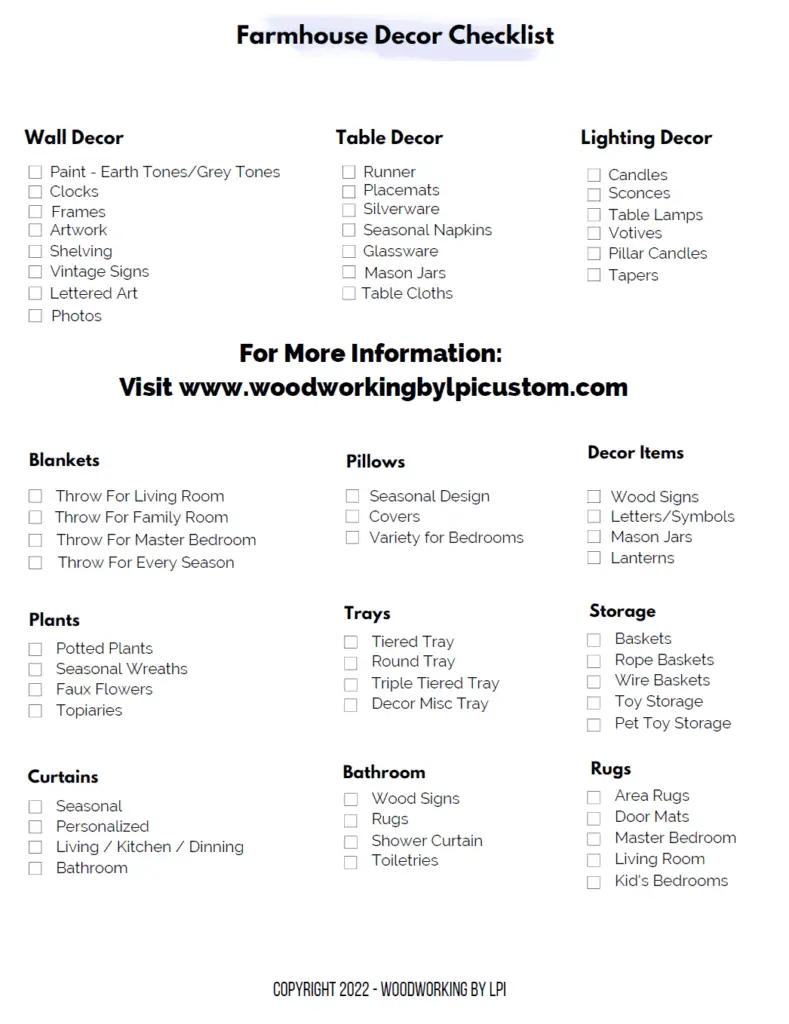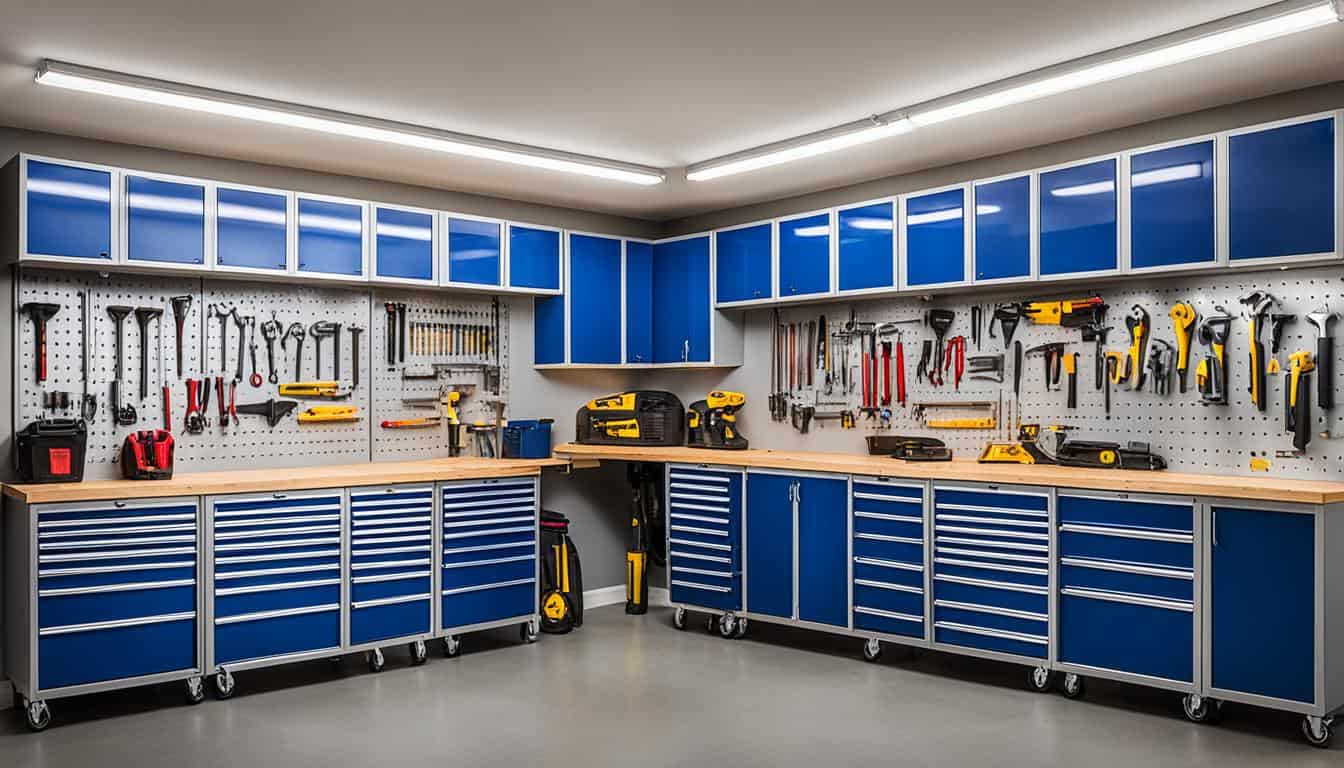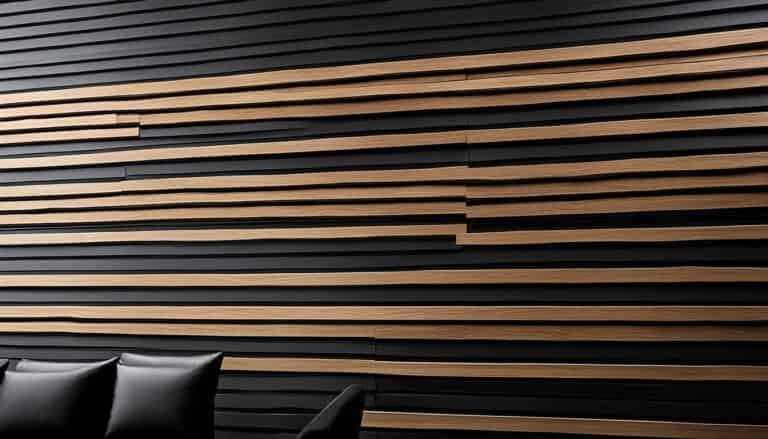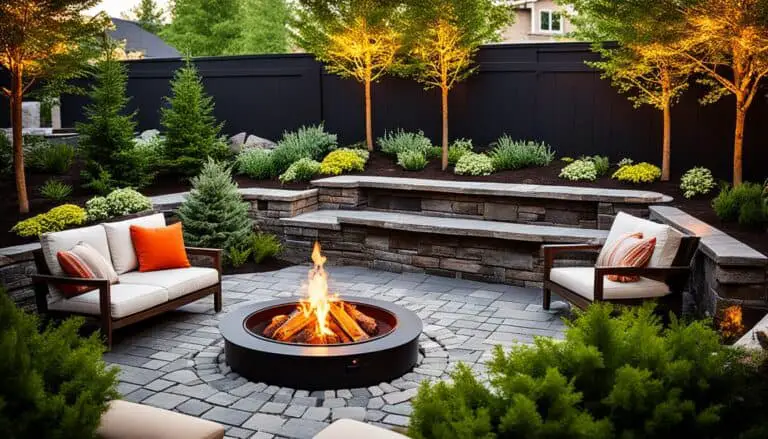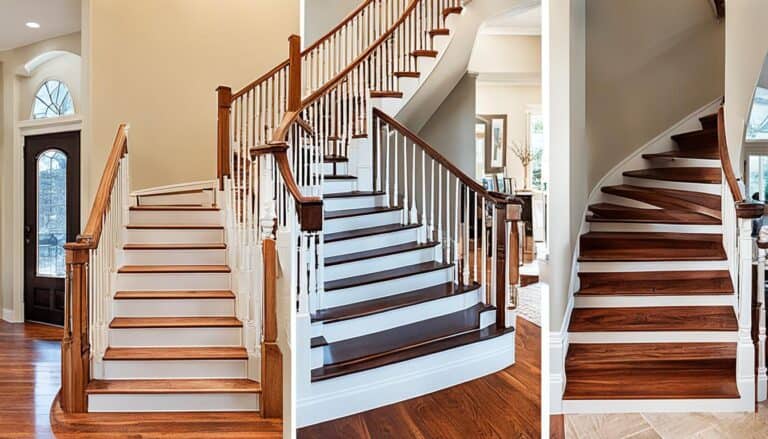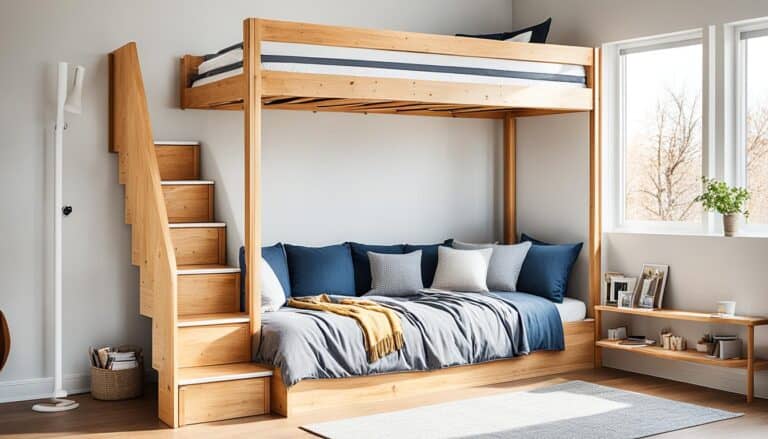Do you struggle with a cluttered and disorganized garage? Are your tools and equipment scattered everywhere, making it difficult to find what you need? It’s time to take control of your garage space and maximize storage with DIY garage cabinets. But where do you start? How do you build your own custom cabinets that fit your garage perfectly and suit your storage needs? Get ready to discover the answers to these questions and more in our comprehensive DIY garage cabinets guide.
Building DIY garage cabinets is not only a practical solution but also a rewarding project that allows you to create a custom organization system tailored to your needs. With the right plans and tips, you can make the most of your garage space and ensure a clutter-free environment. From design and materials to step-by-step instructions, we will provide you with all the information you need to transform your garage into an organized oasis.
So, are you ready to unlock the secrets of DIY garage cabinets and maximize your storage possibilities? Let’s dive in!
- Building DIY garage cabinets allows you to maximize storage and create a custom organization system.
- DIY cabinets offer benefits such as customization, affordability, and design flexibility.
- Planning the design and layout of your cabinets is essential before starting the project.
- Choosing sturdy materials and the right tools is crucial for the longevity and functionality of your cabinets.
- Regular maintenance and safety precautions are necessary to keep your DIY garage cabinets in top condition.
Benefits of DIY Garage Cabinets
DIY garage cabinets offer several benefits for homeowners who are seeking effective garage storage solutions. By building your own cabinets, you have the freedom to customize the design and layout to maximize space and cater to your specific storage needs. This allows you to create a custom garage organization system that is tailored to your preferences.
One of the key advantages of DIY garage cabinets is affordability. Compared to pre-built options, DIY cabinets are often more budget-friendly. By purchasing materials and building the cabinets yourself, you can save on labor costs and have more control over expenses. This makes DIY cabinets an affordable garage storage solution for homeowners looking to improve their garage organization without breaking the bank.
Another advantage of DIY garage cabinets is the ability to choose materials and finishes that align with your personal style and garage décor. You can select the type of wood, hardware, and paint or stain that best match your aesthetic preferences, resulting in a cohesive and visually appealing garage storage solution.
Additionally, DIY garage cabinets allow you to maximize the available space in your garage. You can design the cabinets to fit perfectly into the dimensions of your garage, making efficient use of every inch. Whether you have limited space or a large garage that needs better organization, DIY cabinets can be customized to maximize storage and provide a clutter-free environment.
With DIY garage cabinets, you are in control of the entire process from start to finish. You have the freedom to design, build, and install the cabinets according to your schedule and preferences. This hands-on approach allows you to take pride in your custom garage organization and enjoy the satisfaction of completing a DIY project that improves the functionality and appearance of your garage.
In the next section, we will guide you through the planning process for your DIY garage cabinets, ensuring that you create a cohesive and efficient storage solution for your garage.
Planning Your DIY Garage Cabinets
Before diving into your DIY garage cabinet project, it’s crucial to plan out the design and layout to ensure optimal organization and functionality. Consider the items you need to store and how they can be best organized within the cabinets. Proper planning will help you make the most of your available space and create a personalized storage solution for your garage.
Start by measuring your garage to determine the dimensions of your cabinets. This will ensure they fit seamlessly into your space and provide ample storage. Take into account any specific storage requirements you may have, such as designated areas for tools, sports equipment, or gardening supplies. Taking these needs into consideration will help you design cabinets that cater to your specific storage needs.
Looking for inspiration and guidance? Garage cabinet plans are widely available online, providing you with detailed instructions and blueprints to follow. These plans can serve as a helpful starting point, offering insights into materials, dimensions, and construction techniques. You can also consult with a professional or seek advice from experienced DIYers who have completed similar projects.
Remember, customization is key. Plan your cabinets around your workflow and the tools and equipment you use most frequently. Having a well-organized garage can save you time and effort in the long run, making your DIY garage cabinet project well worth the investment.
Benefits of Planning Your DIY Garage Cabinets:
- Maximize storage space
- Create a personalized organization solution
- Fulfill specific storage requirements
- Design cabinets that cater to your needs
- Save time and effort with an efficient workflow
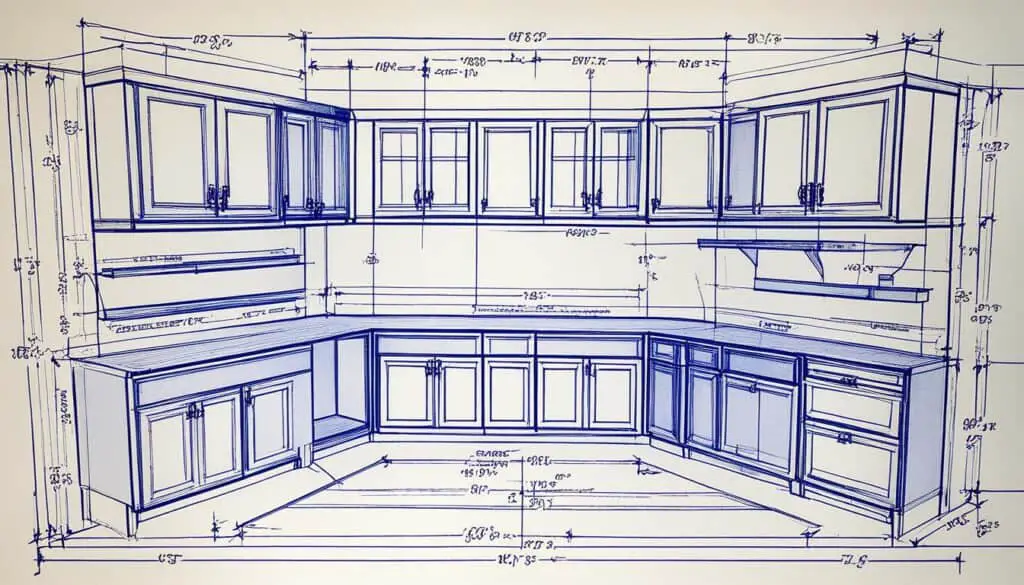
“By planning your DIY garage cabinets upfront, you can optimize your storage space and create a customized organization solution that perfectly suits your needs.”
Choosing Materials for DIY Garage Cabinets
When it comes to building DIY garage cabinets, selecting the right materials is crucial to ensure their durability and functionality in the garage environment. Here are some options to consider:
Cabinet Grade Hardwood Plywood
Cabinet grade hardwood plywood, such as birch, maple, or oak, is a popular choice for DIY garage cabinets. These materials offer exceptional strength and stability, making them ideal for heavy-duty storage needs. Cabinet grade plywood is resistant to warping and can withstand temperature and humidity fluctuations commonly found in garages. By using hardwood plywood, you can be confident in the longevity of your DIY cabinets.
Sanded Pine Plywood
If you’re looking for a more affordable option, sanded pine plywood can be a viable choice for DIY garage cabinets. While it may be less durable compared to hardwood plywood, sanded pine plywood is still a functional and cost-effective option. It is important to note that pine plywood may require additional reinforcement to enhance its strength and stability in garage storage applications.
Additionally, consider using metal hardware and hinges for your DIY garage cabinets. Metal hardware offers added durability and can withstand the demands of frequent use. Ensure that the hardware is corrosion-resistant to combat the moist and potentially corrosive garage environment. By choosing the right materials, you can create sturdy and reliable DIY garage cabinets that will serve your storage needs for years to come.
Affordable Materials Comparison
| Material | Advantages | Disadvantages |
|---|---|---|
| Cabinet Grade Hardwood Plywood | Strength and stability; resistant to warping; durable for heavy-duty storage | Higher cost compared to pine plywood |
| Sanded Pine Plywood | More affordable option; functional and cost-effective | Less durable; may require additional reinforcement |
With the right materials and design, your DIY garage cabinets can provide efficient storage solutions while maintaining their integrity in the garage environment.
Tools and Supplies Needed for DIY Garage Cabinets
To successfully build your own DIY garage cabinets, you will need the following tools and supplies:
- Drill/driver
- Circular saw
- Pocket hole jig
- Shelf pin jig
- Concealed hinge jig
- Brad nailer
- Jig saw
- Speed square
- Miter saw (optional)
- 4×8 sheets of 3/4″ plywood
- 4×8 sheets of 1/4″ plywood
- Butcherblock countertop
- Concealed hinges
- Knobs/handles
- Shelf pins
- 1 1/4″ pocket hole screws
- 3″ wood screws
- Washers
- Stud finder
- Level
- Shims
- Edge banding (optional)
Having the right tools and supplies is essential for successfully building your own DIY garage cabinets. A combination of power tools and woodworking materials will help you achieve professional-looking results. Here is a list of everything you will need to get started:
- Drill/driver: A cordless drill/driver will be your go-to tool for assembling the cabinets and attaching hardware.
- Circular saw: A circular saw is an essential cutting tool for trimming plywood sheets to the desired size.
- Pocket hole jig: A pocket hole jig is used to create strong and hidden joints when joining pieces of wood together.
- Shelf pin jig: A shelf pin jig allows you to drill consistent and precise holes for adjustable shelves.
- Concealed hinge jig: A concealed hinge jig helps you install hinges for cabinet doors with accuracy.
- Brad nailer: A brad nailer is used for attaching trim pieces and securing joints temporarily until the glue dries.
- Jig saw: A jig saw is handy for making curved or detailed cuts in the plywood.
- Speed square: A speed square is a versatile tool that aids in measuring and marking angles.
- Miter saw (optional): A miter saw is useful for making angled cuts when adding decorative moldings or trim.
- 4×8 sheets of 3/4″ plywood: These plywood sheets will serve as the main material for constructing the cabinet boxes.
- 4×8 sheets of 1/4″ plywood: 1/4″ plywood is typically used for the cabinet backs and small interior dividers.
- Butcherblock countertop: A butcherblock countertop can provide a durable and attractive work surface for your cabinets.
- Concealed hinges: Concealed hinges are used to attach the cabinet doors and provide a clean, seamless look.
- Knobs/handles: Choose knobs or handles that match your desired cabinet style and provide easy access.
- Shelf pins: Shelf pins are necessary for adjustable shelves, allowing you to customize the cabinet storage space.
- 1 1/4″ pocket hole screws: Pocket hole screws are used to secure joints made with the pocket hole jig.
- 3″ wood screws: 3″ wood screws are suitable for attaching the cabinets to the wall and securing the countertop.
- Washers: Use washers with the wood screws to ensure a secure and stable attachment to the wall.
- Stud finder: A stud finder will help you locate wall studs for proper cabinet installation.
- Level: A level is essential for ensuring your cabinets are installed straight and level.
- Shims: Shims are useful for adjusting and leveling the cabinets during installation.
- Edge banding (optional): Edge banding can be applied to the exposed edges of plywood to create a finished look.
Having these tools and supplies on hand will make your DIY garage cabinet project smoother and more efficient. Remember to prioritize safety and use appropriate protective gear when working with power tools. Now that you have everything you need, let’s move on to the step-by-step instructions for building your own DIY garage cabinets.
Step-by-Step Instructions for Building DIY Garage Cabinets
Building your own DIY garage cabinets is an exciting project that allows you to customize your storage space according to your needs. Follow these step-by-step instructions to create functional and stylish cabinets for your garage.
Gather Your Materials and Tools
Before you begin building your DIY garage cabinets, gather all the necessary materials and tools. Here’s what you’ll need:
- Plywood panels for the cabinet sides, top, bottom, and back
- A pocket hole jig for drilling pocket holes
- Pocket hole screws and wood glue for assembly
- A shelf pin jig for installing shelf pin holes
- Back braces and face frame pieces
- Hardwood plywood for the cabinet back
- Staples or brad nails for securing the back
- Materials for building and attaching the cabinet doors
- Paint or finish for the cabinets
- Securing hardware for installing the cabinets
- Countertop material
Building Process
- Cut the plywood panels to size for the cabinet sides, top, bottom, and back.
- Use a pocket hole jig to drill pocket holes for assembly.
- Assemble the cabinet box by attaching the sides, top, and bottom with pocket hole screws and wood glue.
- Install shelf pin holes on the cabinet sides using a shelf pin jig.
- Drill pocket holes on the top and bottom pieces for attaching the back braces and face frame.
- Attach the back braces and face frame to the cabinet box using pocket hole screws and wood glue.
- Install a 1/4″ hardwood plywood back on the cabinet using staples or brad nails.
- Build and attach the cabinet doors using pocket hole screws and wood glue.
- Paint or finish the cabinets as desired.
- Install the cabinets in your garage, securing them to the wall studs and adding the countertop.
By following these step-by-step instructions, you can build your own DIY garage cabinets that are not only functional but also add a touch of personalization to your garage storage space.
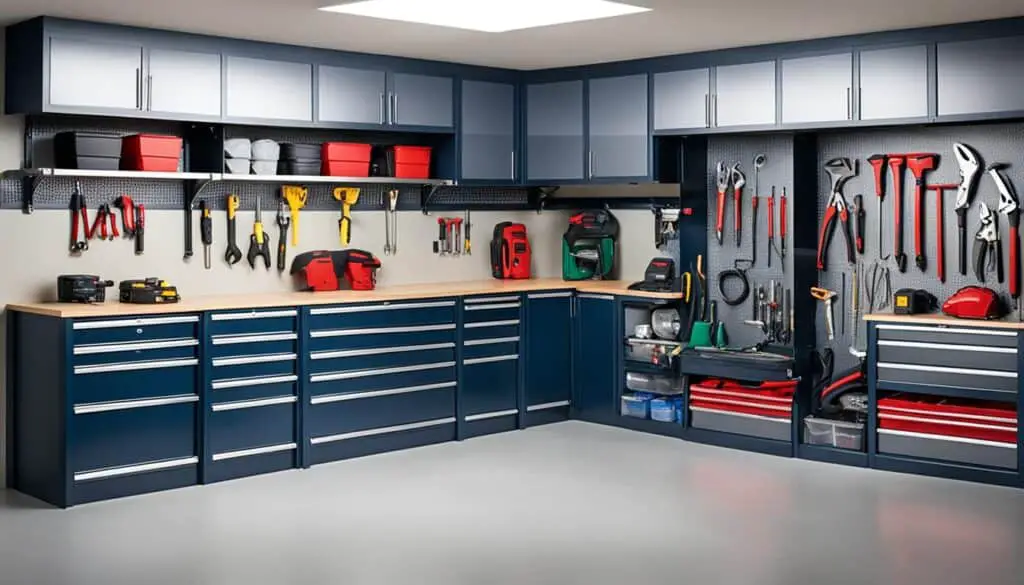
Tips for Customizing and Organizing DIY Garage Cabinets
Customizing and organizing your DIY garage cabinets is essential to maximize their efficiency and functionality. By optimizing the design and implementing smart storage solutions, you can create a space that meets your specific needs. Here are some valuable tips to help you customize and organize your DIY garage cabinets:
Create Adjustable Shelves
Consider adding adjustable shelves to your DIY garage cabinets. This allows you to accommodate items of different sizes and make changes as needed. By providing flexibility, adjustable shelves ensure efficient use of space and prevent wasted areas within the cabinets.
Label and Divide
To keep small tools and accessories organized, use labeled bins, dividers, or trays within your DIY garage cabinets. This provides designated spaces for different types of items, making them easy to find and increasing overall organization.
Utilize Door Storage
Take advantage of the inside of your cabinet doors by installing hooks or pegboards. This additional storage space is perfect for hanging tools, small equipment, or frequently used items. It keeps them easily accessible while maximizing your cabinet’s interior space.
Group Similar Items Together
To enhance organization and efficiency, group similar items together within your DIY garage cabinets. This grouping ensures that everything has a designated spot and eliminates the time wasted searching for specific items.
Prioritize Accessibility
When organizing your DIY garage cabinets, prioritize the accessibility of items based on their frequency of use. Place commonly used tools or supplies within easy reach, while storing less frequently used items in less accessible areas. This approach saves time and streamlines your workflow.
With these tips, you can customize and organize your DIY garage cabinets to maximize their efficiency and create a functional storage solution tailored to your needs.
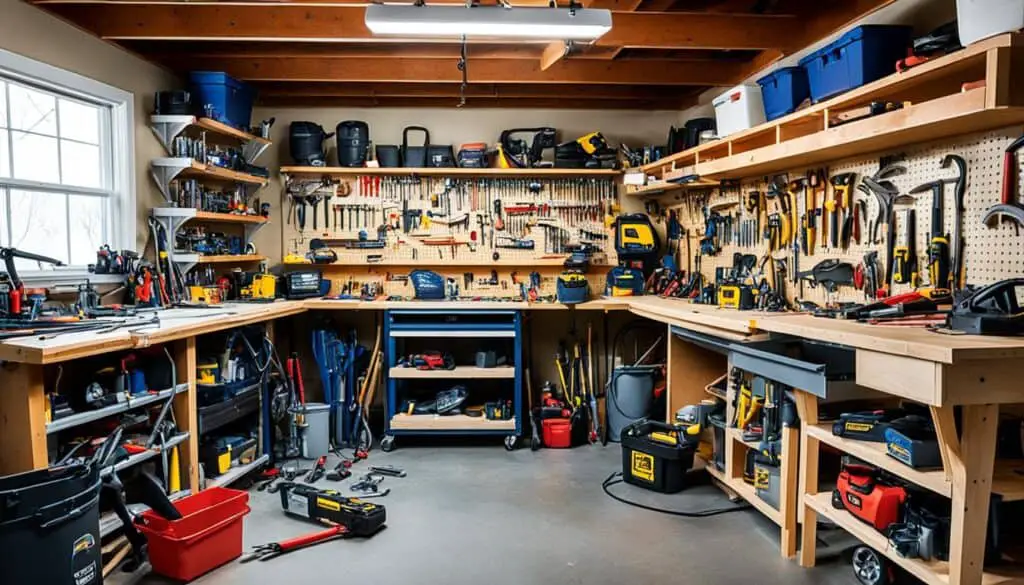
Note: The image above illustrates the importance of tool organization in a garage, showcasing a well-arranged set of tools with designated spaces and labeled storage bins.
Maintenance and Longevity of DIY Garage Cabinets
Proper maintenance is crucial to ensure the longevity and optimal functionality of your DIY garage cabinets. By incorporating regular maintenance practices, you can prevent damage, extend the lifespan of your cabinets, and keep them in top-notch condition. Here are some essential maintenance tips to help you maintain your DIY garage cabinets:
- Clean and Clear: Regularly clean your cabinets to keep them free from dust, dirt, and debris. Use a mild cleanser and a soft cloth to wipe down the surfaces, both inside and out. Avoid using harsh chemicals that can strip the finishes and damage the cabinets.
- Hardware Inspection: Periodically inspect the hardware, including hinges, knobs, and handles, to ensure they are secure and functioning properly. Tighten any loose screws and replace any damaged or worn-out hardware as needed.
- Preventative Repairs: Make it a habit to inspect your cabinets for any signs of wear and tear, such as chipped or cracked surfaces, loose joints, or warping. If you notice any issues, address them promptly to prevent further damage. Repair or replace damaged components to maintain the structural integrity of your cabinets.
- Regular Adjustments: Over time, the doors, drawers, and shelves of your cabinets may require adjustment due to settling or changes in humidity. Regularly check and adjust the hinges, slides, and shelf positions to ensure smooth operation and proper alignment.
- Protective Measures: Take precautionary measures to protect your cabinets from potential damage. Use coasters or mats to prevent water stains or scratches from harsh objects. Avoid placing heavy items on shelves beyond their weight capacity to prevent sagging or warping.
- Finishing Touch: If you have painted or stained cabinets, periodically inspect the finish for any signs of wear or fading. Consider applying a fresh coat of paint or re-staining the cabinets to revive their appearance and protect the wood from moisture and UV damage.
By following these maintenance practices, you can ensure that your DIY garage cabinets remain in excellent condition and provide reliable storage for years to come. Invest the time and effort to maintain your cabinets, and you’ll enjoy a clutter-free and well-organized garage.
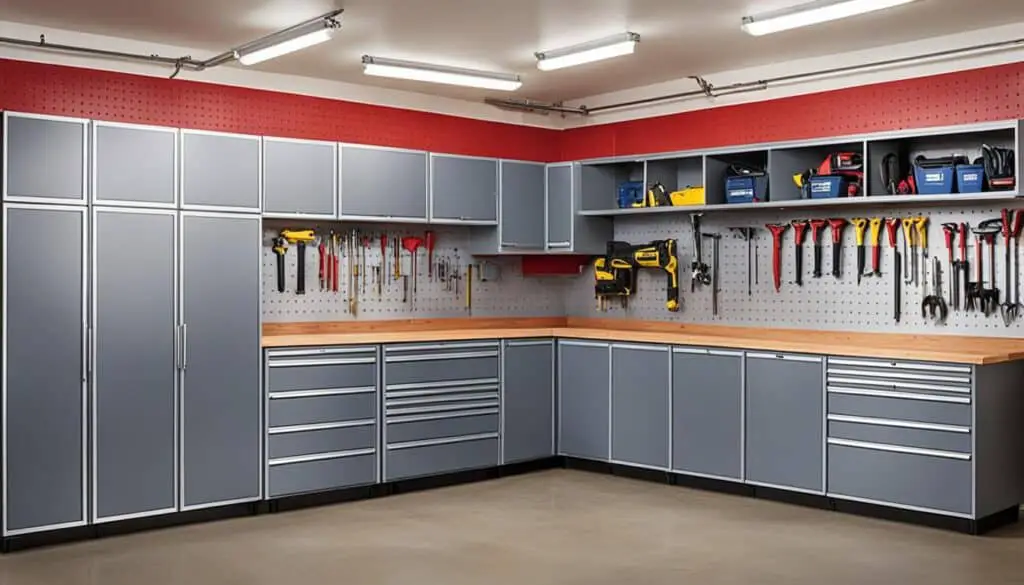
Safety Considerations when Building DIY Garage Cabinets
When embarking on the project of building your own garage cabinets, it is crucial to prioritize safety to ensure a successful and accident-free experience. By following essential safety precautions, you can minimize the risk of injuries and create a safe working environment. Here are some important guidelines:
Use Appropriate Safety Gear
Always wear safety glasses to protect your eyes from flying debris, dust, and particles. Additionally, wear gloves to safeguard your hands while handling tools and materials. These safety measures will greatly reduce the risk of injuries during construction.
Follow Manufacturer Instructions and Safety Guidelines
Pay close attention to the manufacturer’s instructions and safety guidelines provided with your tools and equipment. Adhere to the recommended safety procedures specific to each tool, ensuring proper usage and reducing the chances of accidents.
Practice Proper Lifting Techniques
When maneuvering heavy plywood panels or other bulky materials, it is crucial to apply proper lifting techniques. Bend at the knees and keep your back straight while lifting to avoid strains or injuries. If necessary, seek assistance from a partner to safely handle heavy items.
Secure Cabinets to Wall Studs
To prevent tipping or falling, securely fasten your DIY garage cabinets to the wall studs. Use appropriate screws or brackets for a stable and solid installation. This ensures that your cabinets are safe and secure, even when loaded with heavy tools and equipment.
Caution during Cabinet Door Installation
Exercise caution when installing cabinet doors and ensure they are properly aligned and securely attached. Improperly installed doors can pose a safety hazard and may lead to accidents or injuries. Take your time to align and secure the doors correctly to ensure a safe and functional cabinet system.
By following these safety considerations, you can confidently proceed with building your own garage cabinets, knowing that you have taken the necessary precautions to protect yourself and create a safe working environment.
| Safety Tips for Building DIY Garage Cabinets |
|---|
| Use appropriate safety gear, such as safety glasses and gloves, when handling tools and materials. |
| Follow all manufacturer instructions and safety guidelines for power tools. |
| Practice proper lifting techniques when maneuvering heavy plywood panels. |
| Secure cabinets to wall studs to prevent tipping or falling. |
| Use caution when installing cabinet doors and ensure they are properly aligned and secure. |
Cost Analysis of DIY Garage Cabinets vs. Pre-Built Cabinets
When it comes to garage storage solutions, DIY garage cabinets offer a cost-effective alternative to pre-built cabinets. By opting to build your own cabinets, you have the opportunity to save money on labor costs and customize the design according to your specific needs. Furthermore, DIY cabinets provide flexibility in terms of layout and materials, ensuring you get the most value for your budget and achieve functional and stylish garage storage.
While the upfront costs may vary depending on the materials and finishes you choose, DIY garage cabinets, in general, are an affordable option for homeowners seeking efficient storage solutions. By purchasing the necessary materials and investing your time and effort, you can create custom cabinets that suit your garage layout and storage requirements.
When comparing the cost of DIY garage cabinets to pre-built options, the labor cost is a significant factor that contributes to the overall price difference. With DIY cabinets, you eliminate the expense of hiring professional installers or purchasing ready-to-assemble cabinets. Instead, you can invest that money into better quality materials, hardware, or additional accessories to enhance the functionality and performance of your cabinets.
Additionally, the customization factor is a significant advantage of DIY garage cabinets. When you build your own cabinets, you have the freedom to choose the materials, finishes, and hardware that match your personal style and preferences. This level of customization allows you to create a cohesive look in your garage and ensures that the cabinets seamlessly integrate with your existing decor.
Did You Know?
By building your own DIY garage cabinets, you can save up to 50% when compared to the cost of pre-built cabinets.
However, it’s essential to consider your skill level, available time, and resources before embarking on a DIY cabinet project. Building cabinets requires woodworking knowledge and precise craftsmanship. If you lack experience in carpentry, it may be wise to seek guidance from a professional or attend woodworking classes to ensure the cabinets are built correctly and safely.
| DIY Garage Cabinets | Pre-Built Cabinets | |
|---|---|---|
| Cost | Affordable, lower labor costs | Higher, labor costs included |
| Customization | Fully customizable to your preferences | Limited customization options |
| Quality | Dependent on materials and craftsmanship | Varies based on manufacturer and price range |
| Installation | Requires DIY skills and time investment | Professional installation or assembly required |
Success Stories and Inspiration for DIY Garage Cabinets
Embarking on a DIY garage cabinet project can be both exciting and daunting. However, you’re not alone in your endeavor. Many homeowners have successfully built their own DIY garage cabinets and transformed their garage organization, creating functional and customized storage solutions. Take inspiration from their success stories and learn from their experiences to create the perfect cabinets for your garage.
Online resources such as blogs and forums provide a wealth of inspiration and ideas for customizing and building your own cabinets. Browse through photos, tutorials, and personal stories shared by individuals who have successfully tackled similar projects. Their valuable insights and tips can help you avoid common pitfalls and make informed decisions throughout your DIY journey.
“I never thought I could build my own garage cabinets, but with the help of online tutorials and the support of the DIY community, I successfully transformed my cluttered garage into an organized oasis.” – Emily F.
One benefit of exploring success stories is the opportunity to draw inspiration from different designs and layouts. By seeing what others have accomplished, you can gain a clearer vision of what you want to achieve with your own garage cabinets. Pay attention to the specific features that impress you and consider how they can be adapted to your space and storage needs.
Remember that every DIY project is unique, so don’t be afraid to customize your cabinets to suit your preferences. Whether it’s incorporating specific tool storage solutions, adding adjustable shelving for versatility, or selecting a stylish finish that complements your garage’s aesthetic, you have the freedom to make your cabinets truly one-of-a-kind.
Benefits of Drawing Inspiration from Success Stories
Exploring success stories and learning from others’ experiences can provide several benefits for your DIY garage cabinet project.
- Insight into best practices: Success stories offer valuable insights into the most effective techniques and strategies for building DIY garage cabinets. By understanding the challenges faced by others and the solutions they implemented, you can save time and avoid unnecessary mistakes.
- Motivation and encouragement: Reading about individuals who have successfully completed their DIY projects can be highly motivating and encouraging. It reinforces the belief that you too can achieve your desired outcome, even if you’re a beginner.
- Learning from mistakes: Success stories often include reflections on mistakes made and lessons learned. By learning from others’ experiences, you can avoid common pitfalls and achieve better results.
Remember that while drawing inspiration from success stories is valuable, it’s important to approach your project with your unique vision and requirements in mind. Use the stories as a starting point and adapt the ideas to suit your specific needs and available space.
Now that you’re inspired by the success of fellow DIY enthusiasts, it’s time to embark on your journey to build your own DIY garage cabinets. With careful planning, the right tools, and a touch of creativity, you can transform your garage into a well-organized space that meets your storage needs and reflects your personal style.
| Key Takeaways | Benefits |
|---|---|
| Learn from others’ experiences | Gains insight into best practices and mistakes to avoid |
| Draw inspiration from different designs | Create customized cabinets |
| Motivation and encouragement | Achieve your DIY goals with confidence |
Maintaining Your DIY Garage Cabinets for Long-Term Organization
To maintain long-term organization in your garage, it is important to regularly clean and declutter your DIY garage cabinets. By following a few simple steps, you can keep your cabinets in top shape and ensure they continue to serve as an effective storage solution for years to come.
Step 1: Remove Unused Items
Start by taking inventory of the items in your DIY garage cabinets. Remove any unused or unnecessary items to free up valuable space. This will not only declutter your cabinets but also make it easier to find and access the items you actually need.
Step 2: Wipe Down Shelves and Surfaces
Next, thoroughly wipe down the shelves and surfaces of your DIY garage cabinets to remove dust and debris. Use a damp cloth or a mild cleanser to ensure a clean and fresh environment for your stored items. This simple step can help maintain the longevity of your cabinets and keep them looking their best.
Step 3: Reassess Storage Needs
Periodically reassess your storage needs and make adjustments as necessary. As your needs change over time, you may find that certain items no longer require cabinet space while others need to be prioritized. By staying proactive and organized, you can optimize the functionality of your DIY garage cabinets.
Tip: Consider using labeled bins, dividers, or trays within your cabinets to further enhance organization and keep small tools and accessories easily accessible.
Step 4: Preventative Maintenance
Regular maintenance is key to ensuring the longevity and proper functioning of your DIY garage cabinets. Inspect the hardware and hinges periodically to ensure they are secure and functioning properly. Make any necessary repairs or adjustments as soon as issues arise to prevent further damage.
Step 5: Clean and Declutter Regularly
Lastly, make it a habit to clean and declutter your DIY garage cabinets on a regular basis. Set aside dedicated time to tidy up the cabinets, remove any new clutter, and wipe down surfaces. This will help you maintain a clean and organized garage space.
| Benefits of Maintaining Your DIY Garage Cabinets | Maintenance Tips |
|---|---|
| 1. Maximizes storage efficiency | 1. Regularly inspect hardware and hinges |
| 2. Ensures easy accessibility to stored items | 2. Clean and declutter regularly |
| 3. Extends the lifespan of your cabinets | 3. Reassess storage needs periodically |
| 4. Maintains a clean and organized garage space | 4. Use labeled bins and dividers for organization |
By following these maintenance tips, you can keep your DIY garage cabinets in excellent condition and ensure they continue to provide efficient and customized storage for your garage.
Conclusion
Building DIY garage cabinets is a practical and cost-effective way to maximize your garage space and create a custom organization solution. By following a comprehensive plan and using the right materials and tools, you can build cabinets that meet your unique needs. Whether you want to store tools, sports equipment, or gardening supplies, DIY garage cabinets offer a functional and stylish storage solution.
With careful planning and attention to detail, you can transform your garage into an organized and efficient space. Customizing the design and layout of your cabinets allows you to make the most of your available space and ensure everything has its own place. By utilizing adjustable shelves, labeled bins, and additional storage solutions like hooks or pegboards, you can further enhance the functionality of your DIY garage cabinets.
Start your DIY garage cabinet project today and enjoy the benefits of a clutter-free and well-organized garage. With your own custom-built cabinets, you’ll have ample storage space and a system that suits your specific needs. Say goodbye to the frustration of searching for misplaced items and maximize your garage space with DIY garage cabinets.
FAQ
What are the benefits of building DIY garage cabinets?
Building DIY garage cabinets allows you to customize the design, maximize space, and meet your specific storage needs. DIY cabinets are also more affordable than pre-built options and can be customized to match your garage’s style.
How should I plan my DIY garage cabinets?
Before starting your DIY garage cabinet project, consider the items you need to store, measure your available space, and look for garage cabinet plans online or consult with a professional for guidance. It’s important to take into account specific storage requirements and organize your items accordingly.
What materials should I choose for my DIY garage cabinets?
Cabinet grade hardwood plywood, such as birch, maple, or oak, is recommended for its strength and stability. Alternatively, sanded pine plywood can be a more affordable option. Metal hardware and hinges can also be used for added durability and functionality.
What tools and supplies do I need for building DIY garage cabinets?
You will need tools such as a drill/driver, circular saw, pocket hole jig, and brad nailer. Supplies include 4×8 sheets of plywood, concealed hinges, shelf pins, pocket hole screws, and more.
What are the step-by-step instructions for building DIY garage cabinets?
The step-by-step instructions include cutting plywood panels to size, assembling the cabinet box, installing shelf pin holes, attaching back braces and face frame, building and attaching the cabinet doors, and painting or finishing the cabinets.
How can I customize and organize my DIY garage cabinets?
To customize and organize your DIY garage cabinets, consider adding adjustable shelves, labeled bins or dividers, hooks or pegboards on the inside of cabinet doors, and grouping similar items together for easy access.
How can I maintain the longevity of my DIY garage cabinets?
Regular maintenance is recommended, including keeping the cabinets clean and free from debris, inspecting the hardware and hinges periodically, and making any necessary repairs or adjustments as soon as issues arise.
What safety considerations should I keep in mind when building DIY garage cabinets?
It’s important to use appropriate safety gear, follow manufacturer instructions and safety guidelines for power tools, use proper lifting techniques when maneuvering heavy plywood panels, secure cabinets to wall studs, and exercise caution when installing cabinet doors.
How does the cost of DIY garage cabinets compare to pre-built cabinets?
DIY garage cabinets are generally more cost-effective than pre-built cabinets because you can save money on labor costs and customizations. However, upfront costs may vary depending on materials and finishes chosen.
Where can I find inspiration and success stories for DIY garage cabinets?
Online resources such as blogs and forums provide a wealth of inspiration and ideas from others who have successfully built their own DIY garage cabinets. Explore photos, tutorials, and personal stories to gather ideas for your project.
How can I maintain long-term organization in my DIY garage cabinets?
To maintain long-term organization, regularly clean and declutter your DIY garage cabinets, wipe down shelves and surfaces, reassess storage needs periodically, and make adjustments as necessary to stay proactive and organized.

